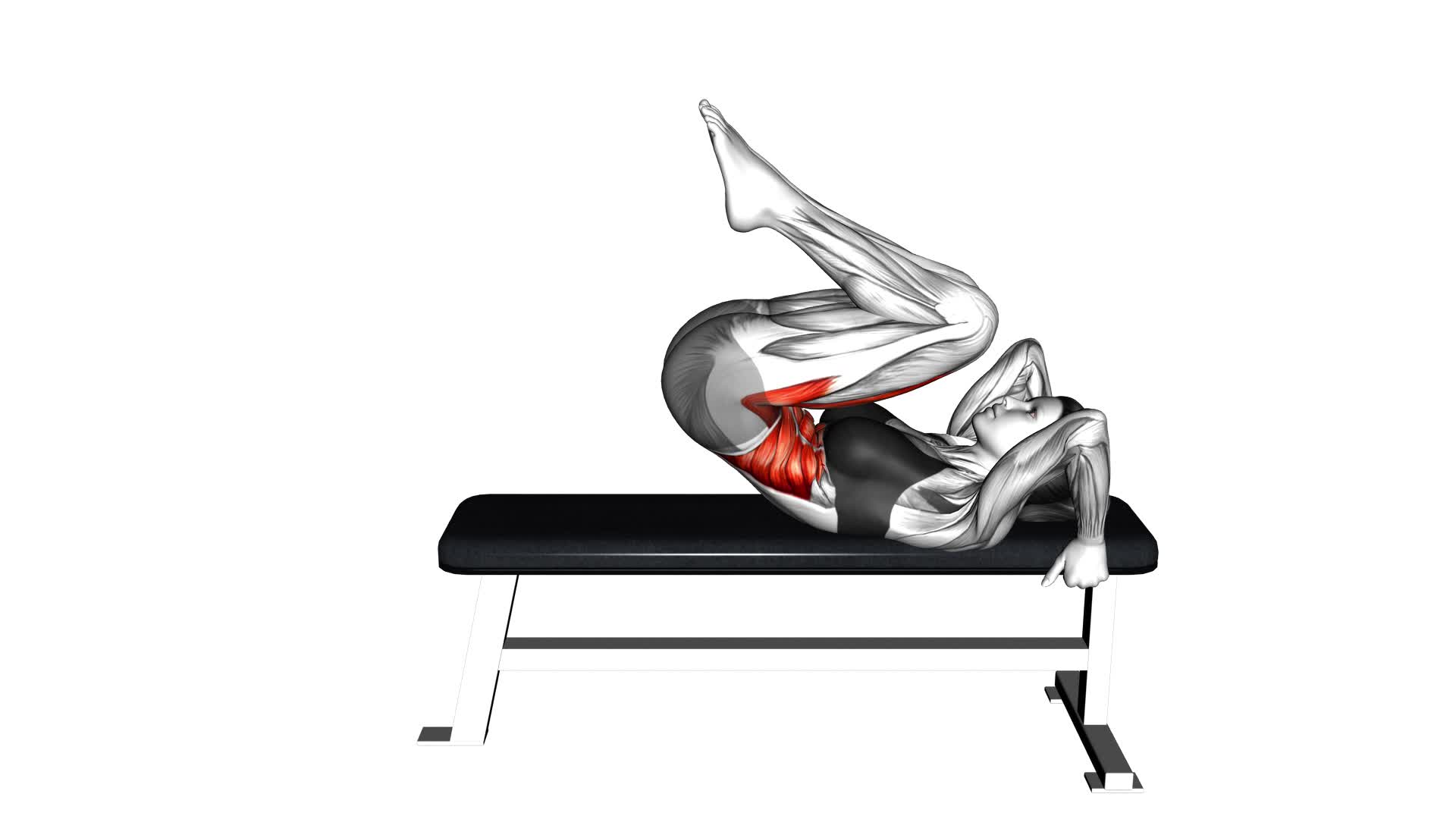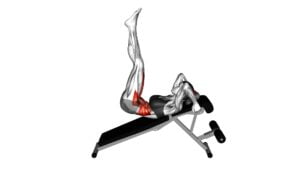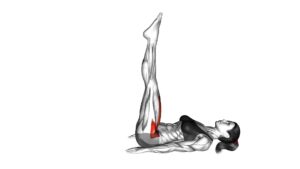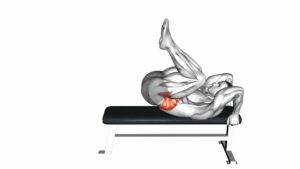Lying Leg Hip Raise (Female) – Video Exercise Guide & Tips

Looking to tone and strengthen your lower body? Check out this video exercise guide for the Lying Leg Hip Raise. In this workout, you'll learn the proper form and technique to effectively target your glutes and hamstrings.
Watch This Exercise Video
Avoid common mistakes and discover variations for all fitness levels. Maximize your results with expert tips.
Get ready to take your leg workouts to the next level with this female-focused exercise. Let's get started!
Key Takeaways
- Lying Leg Hip Raise targets and strengthens glutes, hamstrings, and lower abs.
- It improves lower body strength, stability, and power.
- The exercise engages the gluteus maximus and hamstrings, enhancing athletic performance.
- Lying Leg Hip Raise helps achieve a toned and defined lower body while improving core stability.
Benefits of the Lying Leg Hip Raise
One key benefit of the Lying Leg Hip Raise is that it targets and strengthens your glutes and hamstrings. This exercise specifically works these muscles, helping to tone and build strength in your lower body. By engaging your glutes and hamstrings, you can improve your overall lower body strength, stability, and power.
During the Lying Leg Hip Raise, the main muscles targeted are the gluteus maximus, which is the largest muscle in your buttocks, and the hamstrings, which are the muscles located on the back of your thighs. These muscles play a crucial role in lower body movement and are important for activities such as walking, running, and jumping. By strengthening these muscles, you can improve your athletic performance and reduce the risk of injuries.
To progress and challenge yourself with the Lying Leg Hip Raise, you can make modifications to increase the difficulty. One way to do this is by adding resistance, such as using ankle weights or a resistance band. Another option is to perform the exercise on an unstable surface, like a Swiss ball, to engage your core muscles even more. Additionally, you can increase the number of repetitions or hold the raised position for longer periods of time.
Proper Form and Technique for Lying Leg Hip Raise
To perform the Lying Leg Hip Raise with proper form and technique, you should lie on your back and raise your legs while engaging your core muscles. This exercise primarily targets the lower abdominal muscles and the hip flexors. It's important to maintain proper form to maximize its effectiveness and avoid injury.
One common mistake is lifting the legs too high, which can put excessive strain on the lower back. Instead, focus on lifting the legs until they're perpendicular to the floor, ensuring that the lower back stays in contact with the ground. Another mistake is using momentum to lift the legs, rather than relying on the strength of the abdominal muscles. By engaging your core and moving slowly and controlled, you can effectively target the desired muscle groups.
There are also variations and modifications you can try to add variety and challenge to this exercise. To increase the difficulty, you can add ankle weights or use a stability ball between your feet. Alternatively, if you have lower back issues, you can modify the exercise by bending your knees and lifting them towards your chest. This reduces the strain on the lower back while still engaging the core muscles.
Common Mistakes to Avoid
Avoid these common mistakes when performing the Lying Leg Hip Raise to maximize its effectiveness and prevent injury. Proper execution of this exercise is crucial for targeting the correct muscles and avoiding unnecessary strain.
One common mistake to avoid is lifting your hips too high off the ground. While it may feel like you're working your muscles more by lifting higher, it actually puts excessive pressure on your lower back and can lead to injury. Instead, focus on lifting your hips just high enough to engage your glutes and hamstrings without straining your back.
Another mistake to avoid is using momentum to lift your legs. This takes away from the effectiveness of the exercise and reduces the work your muscles have to do. Instead, concentrate on using controlled and deliberate movements to lift and lower your legs.
Lastly, make sure to keep your core engaged throughout the exercise. Many people tend to let their core relax, which can lead to improper form and reduced effectiveness.
Variations and Modifications for All Fitness Levels
To cater to individuals of all fitness levels, there are various variations and modifications available for the Lying Leg Hip Raise exercise. These modifications allow you to adjust the difficulty of the exercise based on your current fitness level and goals.
For beginners or individuals with limited core strength, a modification you can try is the bent-knee variation. Instead of keeping your legs straight, you can bend your knees and keep your feet flat on the floor. This reduces the amount of tension on your core muscles, making it easier to perform the exercise.
On the other hand, if you're looking to progress and challenge yourself, you can try the single-leg progression. This involves raising one leg off the ground while keeping the other leg extended. This variation increases the demand on your core muscles, as well as your hip stability and balance.
Another modification you can experiment with is the weighted variation. By holding a dumbbell or a medicine ball between your feet, you add resistance to the exercise, making it more challenging for your core muscles.
Tips for Maximizing Your Results
For maximizing your results with the Lying Leg Hip Raise exercise, it's essential to focus on proper form and engage your core muscles throughout the movement. Here are some tips to help you get the most out of this exercise:
- Maintain proper form: Lie flat on your back with your legs straight and your arms by your sides. Keep your core engaged and your lower back pressed firmly into the ground throughout the exercise. This will ensure that you're targeting the right muscles and maximizing the effectiveness of each repetition.
- Control the movement: Slowly lift your legs off the ground, keeping them straight, until they're perpendicular to the floor. Pause for a moment at the top, then slowly lower them back down to the starting position. Avoid using momentum or swinging your legs to complete the movement. Focus on the contraction of your core muscles as you raise and lower your legs.
- Increase difficulty gradually: As you become more comfortable with the exercise, you can make it more challenging by adding ankle weights or using a stability ball between your legs. These modifications will help to further engage your core and increase the intensity of the exercise.
- Combine with a balanced diet: Remember that exercise alone isn't enough to achieve your fitness goals. To maximize your results, pair your Lying Leg Hip Raise with a balanced diet that includes plenty of lean proteins, fruits, vegetables, and whole grains. This will provide your body with the necessary nutrients to fuel your workouts and support muscle growth and repair.
Incorporating these tips into your Lying Leg Hip Raise routine will help you maximize your results and achieve a stronger core. Remember to always listen to your body and make modifications as needed.
Sample Lying Leg Hip Raise Workout Routine
Try incorporating the Lying Leg Hip Raise into your workout routine to strengthen your core and tone your lower body. This exercise is highly effective and can be modified to suit different fitness levels and goals.
One modification you can try is using a stability ball instead of a bench or mat. This will add an extra challenge to your core muscles as you lift your legs. Another modification is to perform the exercise with a resistance band around your thighs. This will engage your hip abductors and add more resistance to the movement.
The lying leg hip raise offers several benefits. Firstly, it targets your glutes, hamstrings, and lower abs, helping you to achieve a more toned and defined lower body. It also improves core stability and strengthens the muscles in your lower back. Additionally, this exercise can help to improve hip mobility and reduce the risk of lower back pain.
To incorporate the lying leg hip raise into your workout routine, start by performing 3 sets of 10-12 repetitions. As you become more comfortable with the exercise, you can increase the number of sets or repetitions. Remember to engage your core and maintain proper form throughout the movement.
Frequently Asked Questions
How Many Calories Does the Lying Leg Hip Raise Burn?
The lying leg hip raise is a beneficial exercise that can help you strengthen your core and glutes. By lifting your legs and hips off the ground, you engage these muscles and promote stability.
To perform this exercise correctly, lie on your back with your legs extended and your arms by your sides. Keep your core engaged as you lift your legs and hips off the ground, then lower them back down.
Can the Lying Leg Hip Raise Help Reduce Belly Fat?
The lying leg hip raise is a beneficial exercise that can help reduce belly fat. By engaging your core muscles and targeting the lower abdomen, this exercise can contribute to toning and strengthening your midsection.
Additionally, there are various variations of the lying leg hip raise that you can incorporate into your routine to maximize its effectiveness. These variations include using a stability ball or adding weights to challenge your muscles even more.
Is It Normal to Feel Lower Back Pain During the Lying Leg Hip Raise?
Feeling lower back pain during the lying leg hip raise isn't uncommon. The causes of lower back pain can vary, including improper form or muscle imbalances.
To prevent lower back pain, it's important to engage your core, maintain proper alignment, and avoid excessive arching of the back. Strengthening your core muscles and practicing proper form can help alleviate and prevent lower back pain during this exercise.
Can the Lying Leg Hip Raise Help Improve Posture?
Improving your posture is important for maintaining a healthy body alignment. The lying leg hip raise can be a helpful exercise in achieving better posture.
By engaging your core muscles and strengthening your lower back, this exercise can improve the stability of your spine and promote proper alignment.
Additionally, the lying leg hip raise can also enhance flexibility in your hips and lower body.
Incorporating this exercise into your routine can contribute to better posture overall.
Are There Any Precautions or Contraindications for Performing the Lying Leg Hip Raise?
When performing the lying leg hip raise, it's important to be aware of any precautions or contraindications. Precautions may include avoiding this exercise if you have any pre-existing injuries or conditions that could be aggravated.
Contraindications may include avoiding this exercise if you're pregnant or have recently undergone surgery.
It's always best to consult with a healthcare professional or fitness instructor before attempting any new exercise to ensure it's safe for you.
Conclusion
The lying leg hip raise is a beneficial exercise that targets the hip and glute muscles. By performing this exercise with proper form and technique, you can maximize your results and avoid common mistakes.
There are also variations and modifications available for all fitness levels. Incorporating the lying leg hip raise into your workout routine can help strengthen and tone your lower body.
Remember to always consult with a fitness professional before starting any new exercise program.

Author
Years ago, the spark of my life’s passion ignited in my mind the moment I stepped into the local gym for the first time. The inaugural bead of perspiration, the initial endeavor, the very first surge of endorphins, and a sense of pride that washed over me post-workout marked the beginning of my deep-seated interest in strength sports, fitness, and sports nutrition. This very curiosity blossomed rapidly into a profound fascination, propelling me to earn a Master’s degree in Physical Education from the Academy of Physical Education in Krakow, followed by a Sports Manager diploma from the Jagiellonian University. My journey of growth led me to gain more specialized qualifications, such as being a certified personal trainer with a focus on sports dietetics, a lifeguard, and an instructor for wellness and corrective gymnastics. Theoretical knowledge paired seamlessly with practical experience, reinforcing my belief that the transformation of individuals under my guidance was also a reflection of my personal growth. This belief holds true even today. Each day, I strive to push the boundaries and explore new realms. These realms gently elevate me to greater heights. The unique combination of passion for my field and the continuous quest for growth fuels my drive to break new ground.







